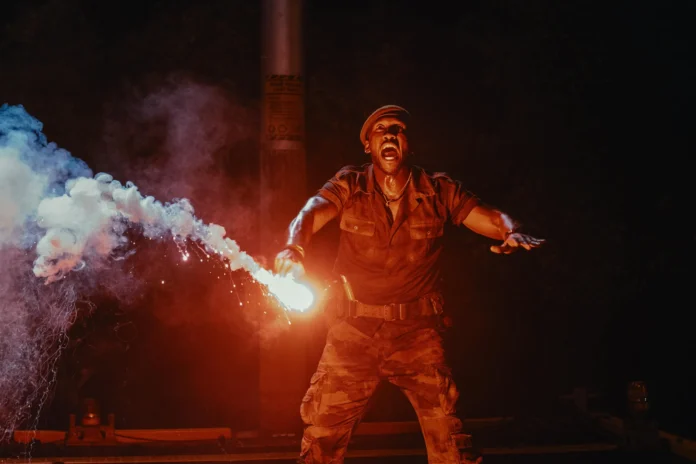It begins, as always, with a gate. A gate that swings open not into Eden, but into another multi-billion-dollar hallucination. Jurassic World Rebirth, the latest installment in the dinosaur-industrial complex, is less a film than a ritual. Not a story, but a return. The dinosaurs are back. The franchise is back. The audience is back. And so is the idea, charming in its persistence, that the cinematic resurrection of extinct reptiles still holds the power to teach us something: about science, about ambition, about ourselves. It does not. But what it does teach, in its own backward way, is worth looking at.
What’s astonishing is not that these creatures are still roaring across IMAX screens, but that we still pretend to be surprised. The premise—cloning as hubris, science as spectacle, nature as something that bites back—has been played so many times it now functions more like a screensaver than a story. And yet we pay, we watch, we perform our role in the fossilized feedback loop. Scarlett Johansson broods; Mahershala Ali moralizes; somewhere, a velociraptor contemplates loyalty; and in the background, a choir of CGI technicians sings hymns to capital and nostalgia.
The film gestures at ethical complexity—bioengineering, pharmaceutical exploitation, ecological collapse—but these themes are never interrogated so much as mood-boarded. Jurassic World Rebirth is less a philosophical meditation than a TED Talk with a body count. The dinosaurs, once metaphors for the sublime and unknowable, are now intellectual wallpaper. It’s not that the movie dumbs down science; it aestheticizes it, reducing biology to a series of glowing beakers and ominous voiceovers.
You might expect postmodernism to intervene here. Jean Baudrillard, watching this from his imaginary bunker beneath Disneyland, would nod solemnly: the simulation has outlived the source. The dinosaurs in this film are not imitations of real animals, but copies of copies of copies. The T-Rex is no longer terrifying; it’s an icon, an emoji with teeth. The terror of extinction has been replaced by the comfort of reappearance. Death, in Jurassic World, is just a pause between sequels.
There’s something almost touching about the film’s sincerity. It wants to say something meaningful about life’s persistence, about the costs of progress, about the old myth that nature can be controlled. But then it forgets, because someone needs to outrun a carnivore on foot. The tension between depth and dopamine never resolves; it simply alternates. There’s a quasi-Heideggerian longing for authenticity, but it’s quickly buried under a landslide of product placement and military-grade dinosaur combat.
What the franchise reveals—what Rebirth amplifies—is not a fascination with dinosaurs, but with return. With looping back to a moment of awe and replaying it until the awe becomes architecture. Nostalgia here isn’t just a mood; it’s a governing principle. The same motifs reemerge (a cup of water trembling, the silhouette of a claw, the piano theme swelling), each time more hyperreal, more divorced from narrative necessity. We don’t want to be told a new story; we want to be reminded of the old one, with just enough variation to justify the ticket price.
And maybe that’s the most honest thing about it. The film doesn’t pretend to be new; it pretends to be new pretending to be old. It’s a copy of a memory you didn’t quite have, a loop masquerading as a line. It believes in the future only insofar as the future allows the past to be franchised.
There are worse things than this kind of artifice, but there are also more interesting ones. Jurassic World Rebirth is not stupid, but it is safe. And safety, for a film about prehistoric predators, is its most dangerous feature. It is not a mistake that these dinosaurs never evolve. The illusion of stasis—prehistoric yet familiar, monstrous yet adorable—is precisely what makes them marketable. Evolution, after all, is risky. It might lead to something we don’t recognize.
So the park reopens. The gate swings wide. The same mistakes are made. And somewhere, in a lab lit like a nightclub, a new creature stirs, perfectly rendered, focus-grouped, and ready for its close-up. Welcome, again, to Jurassic World. It’s not alive. But it moves.
En español
